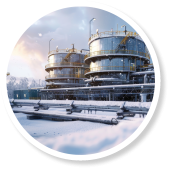https://doi.org/10.15255/KUI.2024.018
Published: Kem. Ind. 74 (1-2) (2025) 33–42
Paper reference number: KUI-18/2024
Paper type: Review
Download paper:  PDF
PDF

Hydrogenases – Types, Sources, Properties, and the Potential for Their Application
A. Marić, A. Radan, N. Milčić, M. Sudar and Z. Findrik Blažević
Abstract
Hydrogenases are a group of versatile metalloenzymes that catalyse the reversible transformation between hydrogen gas and its constituent protons and electrons. These enzymes have gained attention more recently due to their ability to use molecular hydrogen as a substrate in the reactions they catalyse, as well as their potential to synthesise hydrogen, an important biofuel. Although the existence of hydrogenases has been known since the 1930s, current research has not yet made them viable on the industrial scale. They are explored mostly from the biochemical point of view, which is very important, but there is a lack of research on how to adapt these enzymes for real industrial-scale processes. Only a few studies address this gap. Therefore, in this brief literature review, we provide an overview of what is known about hydrogenases. We explore their background, classification, and phylogeny, highlighting their presence in many different sources in nature, such as bacteria, archaea, and certain eukaryotes. We also discuss key factors influencing their activity, along with their advantages and disadvantages. Furthermore, we summarise the methods available for determining their activity and emphasise the need for standardised units to ensure comparability of all data available in the literature. Finally, we discuss their potential applications, particularly in hydrogen production and synthetic reaction pathways for coenzyme regeneration, emphasizing the critical importance of these aspects in the investigation of hydrogenases.

This work is licensed under a Creative Commons Attribution 4.0 International License
Keywords
hydrogenase, coenzyme regeneration, hydrogen production, hydrogenase classification, hydrogenase properties









